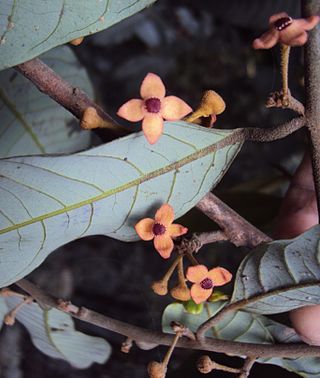
The Myristicaceae are a family of flowering plants native to Africa, Asia, Pacific islands, and the Americas and has been recognized by most taxonomists. It is sometimes called the "nutmeg family", after its most famous member, Myristica fragrans, the source of the spices nutmeg and mace. The best known genera are Myristica in Asia and Virola in the Neotropics.

The capped langur is a primate species in the family Cercopithecidae native to subtropical and tropical dry forests in northeast India, Bhutan, Bangladesh and Myanmar. It is arboreal and feeds on 43 plant species.
Knema alvarezii is a species of plant in the family Myristicaceae. It is endemic to the Philippines.

Knema is a genus of plant in family Myristicaceae, mostly consisting of small-medium trees found in lowland tropical forests from south and northeast of India, Indochina, Malay Archipelago to near the tip of New Guinea. The highest diversity of species is in Borneo in west of Malesia.

Knema attenuata is a species of plant in the family Myristicaceae. It is endemic to India.
Knema communis is a species of plant in the family Myristicaceae. It is a tree found in Peninsular Malaysia and Singapore. It is threatened by habitat loss.

Knema globularia or seashore nutmeg is a species of plant in the family Myristicaceae. It is a tree found in Cambodia, China, India and Southeast Asia. It grows on rocky and sandy coasts, riverbanks, and lowland forests.
Knema glomerata is a species of plant in the family Myristicaceae. It is a tree found in Borneo, the Moluccas and the Philippines.
Knema kinabaluensis is a species of plant in the family Myristicaceae. It is endemic to Borneo where it is confined to Sabah. It grows in montane rain forest from 1,000 to 2,300 metres elevation.
Knema matanensis is a species of plant in the family Myristicaceae. It is a tree endemic to Sulawesi in Indonesia.
Knema pierrei is a species of plant in the family Myristicaceae. It is endemic to Vietnam and was thought to be VUlnerable. However, according to The Plant List and GBIF, K. peirrei is a synonym of Knema furfuracea(Hook. f. & Thomson) Warb.
Knema piriformis is a species of plant in the family Myristicaceae. It is a tree endemic to Borneo.
Knema ridsdaleana is a species of plant in the family Myristicaceae. It is endemic to the Philippines.
Knema rubens is a species of plant in the family Myristicaceae. It is found in Indonesia, Malaysia, and Singapore.

Knema saxatilis is a species of plant in the family Myristicaceae. It is endemic to Vietnam.
Knema sericea is a species of plant in the family Myristicaceae. It is a tree endemic to Borneo.
Knema steenisii is a species of plant in the family Myristicaceae. It is a tree endemic to Flores in Indonesia.
Knema stenocarpa is a species of plant in the family Myristicaceae. It is endemic to the Philippines.
Knema stylosa is a species of plant in the family Myristicaceae. It is a tree endemic to Borneo.
Knema viridis is a species of plant in the family Myristicaceae. It is a tree endemic to Borneo where it is confined to Sarawak.






